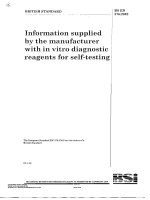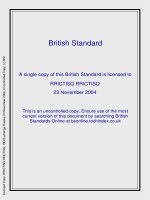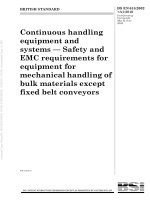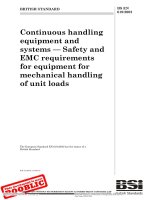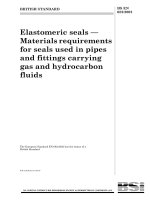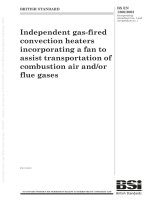Bsi bs en 61685 2002
Bạn đang xem bản rút gọn của tài liệu. Xem và tải ngay bản đầy đủ của tài liệu tại đây (454.52 KB, 42 trang )
BRITISH STANDARD
Ultrasonics — Flow
measurement
systems — Flow test
object
The European Standard EN 61685:2001 has the status of a
British Standard
ICS 17.120.01; 17.140
NO COPYING WITHOUT BSI PERMISSION EXCEPT AS PERMITTED BY COPYRIGHT LAW
BS EN
61685:2002
IEC
61685:2001
BS EN 61685:2002
National foreword
This British Standard is the official English language version of
EN 61685:2001. it is identical with IEC 61685:2001
The UK participation in its preparation was entrusted to Technical Committee
EPL/87, Ultrasonics, which has the responsibility to:
—
aid enquirers to understand the text;
—
present to the responsible international/European committee any
enquiries on the interpretation, or proposals for change, and keep the
UK interests informed;
—
monitor related international and European developments and
promulgate them in the UK.
A list of organizations represented on this committee can be obtained on
request to its secretary.
From 1 January 1997, all IEC publications have the number 60000 added to
the old number. For instance, IEC 27-1 has been renumbered as IEC 60027-1.
For a period of time during the change over from one numbering system to the
other, publications may contain identifiers from both systems.
Cross-references
The British Standards which implement international or European
publications referred to in this document may be found in the BSI Standards
Catalogue under the section entitled “International Standards Correspondence
Index”, or by using the “Find” facility of the BSI Standards Electronic
Catalogue.
A British Standard does not purport to include all the necessary provisions of
a contract. Users of British Standards are responsible for their correct
application.
Compliance with a British Standard does not of itself confer immunity
from legal obligations.
This British Standard, having
been prepared under the
direction of the
Electrotechnical Sector Policy
and Strategy Committee, was
published under the authority
of the Standards Policy and
Strategy Committee on
14 February 2002
Summary of pages
This document comprises a front cover, an inside front cover, the EN title page,
pages 2 to 38, an inside back cover and a back cover.
The BSI copyright date displayed in this document indicates when the
document was last issued.
Amendments issued since publication
Amd. No.
© BSI 14 February 2002
ISBN 0 580 38950 2
Date
Comments
EUROPEAN STANDARD
EN 61685
NORME EUROPÉENNE
EUROPÄISCHE NORM
October 2001
ICS 17.140.50
English version
Ultrasonics Flow measurement systems Flow test object
(IEC 61685:2001)
Ultrasons Systèmes de mesure de débit Montage pour essai de débit
(CEI 61685:2001)
Ultraschall Durchflussmesssysteme Durchfluss-Doppler-Prüfobjekt
(IEC 61685:2001)
This European Standard was approved by CENELEC on 2001-09-01. CENELEC members are bound to
comply with the CEN/CENELEC Internal Regulations which stipulate the conditions for giving this European
Standard the status of a national standard without any alteration.
Up-to-date lists and bibliographical references concerning such national standards may be obtained on
application to the Central Secretariat or to any CENELEC member.
This European Standard exists in three official versions (English, French, German). A version in any other
language made by translation under the responsibility of a CENELEC member into its own language and
notified to the Central Secretariat has the same status as the official versions.
CENELEC members are the national electrotechnical committees of Austria, Belgium, Czech Republic,
Denmark, Finland, France, Germany, Greece, Iceland, Ireland, Italy, Luxembourg, Malta, Netherlands,
Norway, Portugal, Spain, Sweden, Switzerland and United Kingdom.
CENELEC
European Committee for Electrotechnical Standardization
Comité Européen de Normalisation Electrotechnique
Europäisches Komitee für Elektrotechnische Normung
Central Secretariat: rue de Stassart 35, B - 1050 Brussels
© 2001 CENELEC - All rights of exploitation in any form and by any means reserved worldwide for CENELEC members.
Ref. No. EN 61685:2001 E
Page 2
EN 61685:2001
EN 58616:2001
-2-
Foreword
The text of document 87/202/FDIS, future edition 1 of IEC 61685, prepared by IEC TC 87, Ultrasonics,
was submitted to the IEC-CENELEC parallel vote and was approved by CENELEC as EN 61685 on
2001-09-01.
The following dates were fixed:
– latest date by which the EN has to be implemented
at national level by publication of an identical
national standard or by endorsement
(dop) 2002-06-01
– latest date by which the national standards conflicting
with the EN have to be withdrawn
(dow) 2004-09-01
Annexes designated "normative" are part of the body of the standard.
Annexes designated "informative" are given for information only.
In this standard, annexes B and ZA are normative and annexes A, C, D, E and F are informative.
Annex ZA has been added by CENELEC.
__________
Endorsement notice
The text of the International Standard IEC 61685:2001 was approved by CENELEC as a European
Standard without any modification.
__________
Page 3
EN 61685:2001
58616 Ó (1002:CEI)E
–3–
CONTENTS
INTRODUCTION .................................................................................................................... 5
1
Scope .............................................................................................................................. 6
2
Normative references ....................................................................................................... 6
3
Definitions........................................................................................................................ 6
4
List of symbols ................................................................................................................12
5
General outline of flow Doppler test object.......................................................................13
6
Specification of the flow Doppler test object.....................................................................13
7
8
6.1 General .................................................................................................................13
6.2 Blood-mimicking fluid (BMF) ..................................................................................14
6.3 Tube ......................................................................................................................15
6.4 Tissue-mimicking material (TMM)...........................................................................16
6.5 Geometry...............................................................................................................16
Precautions to prevent changes in the composition of the blood-mimicking fluid
(BMF) .............................................................................................................................16
Specifications for labelling...............................................................................................17
www.bzfxw.com
Annex A (informative) Rationale concerning the position of this standard ..............................18
Annex B (normative) Formulae relating various quantities .....................................................21
Annex C (informative) Rationale for the numerical values chosen in this standard .................22
Annex D (informative) Description of an example flow Doppler test object .............................24
Annex E (informative) Schematic diagram of a possible flow circuit .......................................33
Annex F (informative) Measuring methods ............................................................................34
Annex ZA (normative) Normative references to international publications with their
corresponding European publicatins ................................................................................38
Bibliography ..........................................................................................................................35
Figure 1 – Three configurations for Doppler flow test objects .................................................13
Figure D.1 – The main elements of a flow test object .............................................................25
Figure D.2 – Backscattering coefficient of BMF as a function of frequency .............................27
Figure D.3 Attenuation of TMM (ă
ă ) and BMF (¡
¡ ) as a function of frequency .......................27
Figure D.4 – Attenuation of ultrasound by material of tube wall, as a function of
frequency ..............................................................................................................................28
Figure D.5 – Deformation of velocity spectrum of parabolic flow by attenuation due to
tube wall (wall thickness 1,5 mm)...........................................................................................29
Figure D.6 – Backscattering coefficient of two samples of TMM as a function of
frequency ..............................................................................................................................30
Figure D.7 – The quotient of attenuation by TMM (1-way passage) and frequency as a
function of frequency .............................................................................................................30
Figure D.8 – Testing for penetration depth .............................................................................32
Figure E.1 – Schematic diagram of a possible flow circuit, showing the place of the flow
Doppler test object ................................................................................................................33
Page 4
EN 61685:2001
–4–
58616 Ó (1002:CEI)E
Table 1 – Typical ranges of parameters for blood at 37 °C, where f is the acousticworking frequency in hertz .....................................................................................................14
Table 2 – Specification of blood-mimicking fluid (BMF) ..........................................................14
Table 3 – Parameters of tissue-mimicking material (TMM) .....................................................16
Table A.1 – Parameters concerning CW Doppler ...................................................................19
Table A.2 – Additional parameters concerning pulsed Doppler and colour flow .......................20
www.bzfxw.com
Page 5
EN 61685:2001
58616 Ó (1002:CEI)E
–5–
INTRODUCTION
The purpose of this International Standard is to establish a flow Doppler test object for the
acceptance testing, quality assurance testing and clinical calibration of Doppler systems,
working at a frequency between 2 MHz and 10 MHz. As the response of Doppler systems
depends on the signal level and on the spectral contents of the signal, it is desirable to test
some aspects of a Doppler system with a test object that mimics the in vivo situation. A flow
Doppler test object is particularly useful for
-
testing the influence of the size and the depth of the blood vessel on the signal recorded by
a Doppler system;
-
testing the response of a Doppler system with a spectrum of blood velocities typical of the
in vivo situation.
This flow test object is not intended as a phantom mimicking clinical conditions.
The basis of this International Standard is given by IEC Technical Report 61206:1993
Ultrasonics – Continuous Wave Doppler systems – Test procedures. In annex A the position of
this standard in relation to IEC 61206 and IEC 61895 is described. This standard only declares
parameters that can be measured with the test object. Measurement methods are given in
IEC 61206 and IEC 61895.
This International Standard deals only with the flow Doppler test object in a restricted sense,
i.e. the section in which the ultrasonic measurements are performed. Where the whole of the
set-up is meant, the phrase 'flow rig' is used. The prescriptions of this International Standard
define the ultrasonic properties and the flow pattern in the measurement section of the flow
test object. For other aspects of the flow rig (i.e. generating and measuring flows) standard
engineering practice has to be followed.
www.bzfxw.com
The flow conditions are simplified as much as possible: a steady flow through a straight tube
with a circular cross-section. Generalisation of the flow conditions to other geometries and time
dependent flows is required in order to test some instrument functions. This generalisation is
not undertaken in this International Standard.
In annex D, an example flow Doppler test object is described which complies with the
requirements of this International Standard. Compliance with this International Standard can
also be fulfilled by measuring the properties of the materials to be used, and complying with
the values given in this International Standard.
In literature [1], [2] the nomenclature about the primary measurand of Doppler systems is
confused. 'Doppler frequency' and 'velocity' occur on equal footing. In 'velocity' often a
correction for Doppler angle has been included. To avoid this ambiguity, in this International
Standard the term 'Doppler frequency' is preferred. In case a Doppler system is declared to
measure velocity, it is intended that measured values are converted to Doppler frequency,
using acoustic working frequency and, if applicable, Doppler angle.
Page 6
EN 61685:2001
–6–
58616 Ó (1002:CEI)E
ULTRASONICS – FLOW MEASUREMENT SYSTEMS –
FLOW TEST OBJECT
1
Scope
This International Standard specifies parameters for a flow Doppler test object representing
a blood vessel of known diameter at a certain depth in human tissue, carrying a steady flow.
This International Standard establishes a flow Doppler test object which can be used to
assess various aspects of the performance of Doppler diagnostic equipment.
2
Normative references
The following normative documents contain provisions which, through reference in this text,
constitute provisions of this International Standard. For dated references, subsequent
amendments to, or revisions of, any of these publications do not apply. However, parties to
agreements based on this International Standard are encouraged to investigate the possibility
of applying the most recent editions of the normative documents indicated below. For undated
references, the latest edition of the normative document referred to applies. Members of IEC
and ISO maintain registers of currently valid International Standards.
IEC 61206:1993, Ultrasonics – Continuous-wave Doppler systems – Test procedures
www.bzfxw.com
IEC 61102:1991, Measurement and characterisation of ultrasonic fields using hydrophones in
the frequency range 0,5 MHz to 15 MHz
IEC 61895:1999, Ultrasonics – Pulsed Doppler diagnostic systems – Test procedures to
determine performance
3
Definitions
For the purposes of this International Standard, the following definitions apply:
3.1
–3 dB Doppler frequency
frequency at which the power per unit frequency in the Doppler spectrum is half (–3 dB) of the
maximum value
3.2
–3 dB sample volume
volume of a region in space for which the Doppler system gives a response to a point Doppler
target that is above –3 dB from the maximal response, taking account of the effects of both
transmission and reception
Unit: cubic millimetre, mm 3
3.3
–3 dB sample volume length
largest dimension of the –3 dB sample volume in the direction of the beam alignment axis
(see 3.5 of IEC 61102)
Unit: millimetre, mm
Page 7
EN 61685:2001
58616 Ó (1002:CEI)E
–7–
3.4
–3 dB sample volume width
largest value of the dimension of the –3 dB sample volume along an axis which is
perpendicular to the beam alignment axis. In case the Doppler system has a scan plane, the
axes are taken in the scan plane and perpendicular to the scan plane
Unit: millimetre, mm
3.5
acoustic-working frequency
frequency of an acoustic signal based on the output observed by a hydrophone placed in an
acoustic field: it is the arithmetic mean of the two frequencies at which the amplitude of the
acoustic pressure spectrum is 3 dB below the peak amplitude
[conforms to 3.4.2 of IEC 61102]
Unit: hertz, Hz
3.6
aliasing
false indication of signal frequency as a result of sampling at too low a frequency
NOTE
The threshold for aliasing depends on pulse repetition frequency and a possible base line shift.
3.7
average frequency of the Doppler spectrum
parameter estimated by clinical Doppler systems for the short-time average in a Doppler
spectrum, ignoring the contributions from noise
www.bzfxw.com
NOTE The average frequency of the Doppler spectrum is generally determined for a small time interval,
typically 2 ms to 20 ms).
Unit: hertz, Hz
3.8
axial response range
depth range in tissue over which a signal from a specific target plus noise is at least 3 dB
above the noise level
[see 2.4.1 of IEC 61206]
Unit: millimetre, mm
3.9
blood-mimicking fluid (BMF)
fluid which simulates blood acoustically and is moved at a known flow rate through the flow
Doppler test object
3.10
channel separation
ratio of the signal level in the signal channel corresponding to the movement in the test object
(the desired output voltage) and the signal level in the opposite channel (the undesired output
voltage)
NOTE Channel separation is to be quoted in decibels as twenty times the logarithm of the desired output to the
undesired output voltage.
[see 2.6.1 of IEC 61206]
Unit: decibel, dB
Page 8
EN 61685:2001
–8–
58616 Ó (1002:CEI)E
3.11
colour display spatial resolution
minimum separation in space for which two separate moving point targets or line targets can
be resolved
NOTE The colour display spatial resolution is measured in three directions: 1) along the beam alignment axis,
2) the direction perpendicular to the scan plane and 3) the direction in the scan plane perpendicular to the beam
alignment axis.
Unit: millimetre, mm
3.12
dead zone boundary
boundary of the region close to the transducer in which the system is insensitive to movement
3.13
depth of measurement
distance from the surface of the tissue-mimicking material to the centre of the tube. In case
various attenuating materials, not being tissue-mimicking material or blood-mimicking
material, are present in the ultrasonic path, the depth of measurement is taken to be the
equivalent distance in the tissue-mimicking material, from the surface of the tissuemimicking material to the centre of the tube, over which the attenuation is the same as that in
the actual path in the flow Doppler test object
(see also annex B)
Symbol: M
Unit: millimetre, mm
www.bzfxw.com
3.14
Doppler angle
acute angle between the Doppler beam axis used for the Doppler measurement and the axis of
the tube
Symbol: G
Unit: degree, °
3.15
Doppler angle error
difference between the measurement of the Doppler angle and its true value
Unit: degree, °
3.16
Doppler frequency –3 dB response range
frequency region in the Doppler spectrum around the frequency where power per unit
frequency is maximal, which is delimited by the nearest –3 dB Doppler frequencies
Unit: hertz, Hz
NOTE
The Doppler frequency response range at another signal level may be used in an analogous way.
3.17
Doppler frequency non-linearity error
largest frequency deviation of a data point from the least squares fitted line through the origin
in a plot of Doppler frequency versus observed velocity over the Doppler frequency –3 dB
response range
[see 2.3.2 of IEC 61206]
Unit: hertz, Hz
Page 9
EN 61685:2001
58616 Ó (1002:CEI)E
–9–
3.18
Doppler frequency response
Doppler signal level (in dB) as a function of Doppler frequency
3.19
dynamic range
ratio (in decibels) between the largest Doppler signal which can be processed by the system
without generating spurious outputs and the smallest Doppler signal which can be detected
NOTE Dynamic range is a measure of the ratio between the maximum allowable signal from clutter and the minimum signal level at which flow can be detected.
Unit: decibel, dB
3.20
fixed target effect on sensitivity
change in Doppler output level (in decibels) when a strongly reflecting stationary structure (a
perfect reflector, see 2.3.3.2 of IEC 61206) is brought into the Doppler beam
Unit: decibel, dB
3.21
flow Doppler test object
physical model of blood flowing within a vessel that is embedded in soft tissue. The object is
composed of tissue-mimicking material through which blood-mimicking material is caused
to flow
www.bzfxw.com
3.22
frequency to colour translation table
table which describes the way in which Doppler frequencies are mapped to colours for display
3.23
highest detectable Doppler frequency
Doppler frequency corresponding to the highest observed velocity which can be determined
unambiguously (without aliasing)
Unit: hertz, Hz
3.24
inner diameter
inner diameter of the tube through which the blood-mimicking fluid flows
Symbol: D
Unit: millimetre, mm
3.25
inlet length
distance over which the tube must have a uniform cross-section in order to ensure that a well
defined velocity distribution develops which is independent of the flow conditions at the entry of
the tube
Symbol: L
Unit: millimetre, mm
Page 10
EN 61685:2001
– 01 –
58616 Ó (1002:CEI)E
3.26
intrinsic spectral broadening
width of the frequency region over which the spectral intensity is above –3 dB from its maximal
value, when the Doppler system observes a moving target having a single velocity
Unit: hertz, Hz
3.27
lowest detectable Doppler frequency
Doppler frequency corresponding to the lowest observed velocity which can be distinguished
from noise
Unit: hertz, Hz
3.28
maximum frequency of the Doppler spectrum
parameter estimated by a Doppler system for the highest occurring frequency in a Doppler
spectrum, ignoring the contributions from noise
NOTE 1 The maximum frequency of the Doppler spectrum corresponds to the highest velocity occurring in the
sample volume at a certain time.
NOTE 2 Clinical Doppler systems generally determine the maximum frequency of the Doppler spectrum for a
small time interval (typically 2 ms to 20 ms).
Unit: hertz, Hz
3.29
observed velocity
component of the velocity of a scatterer that is directed towards or away from the transducers
[definition 1.3.10 of IEC 61206]
www.bzfxw.com
3.30
parabolic velocity profile
axisymmetrical flow distribution in a cross-section of the tube, in which the velocity decreases
in proportion to the square of the distance from the tube’s axis, and the velocity at the tube
wall is zero
3.31
penetration depth
maximum depth in tissue-mimicking material from which a Doppler signal can be detected
from noise
Unit: millimetre, mm
3.32
sample volume position error
difference between the centre of the sample volume on the image and its true position
Unit: millimetre, mm
3.33
tissue-mimicking material (TMM )
material whose pertinent ultrasonic properties (sound velocity, attenuation and scattering) are
similar to those of soft tissue
Page 11
EN 61685:2001
58616 Ó (1002:CEI)E
– 11 –
3.34
tube
conduit which carries the blood-mimicking fluid (BMF) flow
NOTE
The word tube also applies to the case of a hole in the tissue-mimicking material.
3.35
volume flow measurement error
100 times the absolute value of the difference between the Doppler measurement of a
particular volume flow rate and its true value, divided by the true value
NOTE
The volume flow measurement error has a sign and is reported as a percentage.
www.bzfxw.com
Page 12
EN 61685:2001
– 21 –
58616 Ó (1002:CEI)E
3.36
wall thickness
thickness of the wall of the tube
NOTE
In the case of a hole in the tissue-mimicking material, the value of the wall thickness is zero.
Symbol: w
Unit: millimetre, mm
3.37
working distance
distance between the transducer and a specific target in tissue-mimicking material when the
signal is maximal
Unit: millimetre, mm
3.38
zero-velocity noise level
r.m.s. voltage of the signal (in dB) on the Doppler output connector under the condition that the
moving portion of the Doppler test object is stopped
Unit: decibel, dB
NOTE 1
NOTE 2
Generally the zero-velocity noise level is the sum of the system noise level and the clutter noise level.
Zero-velocity noise level is reported as dB with respect to 1 mV r.m.s.
4
List of symbols
c
= velocity of sound
cw = velocity of sound in the wall material
ct
www.bzfxw.com
= velocity of sound in the tissue-mimicking material
cb = velocity of sound in the blood-mimicking fluid
D = inner diameter of tube
f
= acoustic-working frequency of the investigated equipment
h
= path length in TMM
L
= inlet length
M = depth of measurement *
q
= flow rate of blood-mimicking fluid
Re = Reynolds number *
v
= local velocity of blood-mimicking fluid
v avg = velocity averaged over the cross-section of the tube *
v max= the highest velocity occurring in a cross-section of the tube *
w = wall thickness of tube
Z
= characteristic acoustic impedance *
=
= attenuation coefficient of sound
D
= viscosity of a blood-mimicking fluid
G
= Doppler angle
H
= density of material
I
= differential scattering cross-section in the backward direction per unit volume, also called
backscatter coefficient
NOTE
For quantities marked with an asterisk, formulae are given in annex B.
Page 13
EN 61685:2001
58616 Ó (1002:CEI)E
5
– 31 –
General outline of flow Doppler test object
An example showing the place of the flow Doppler test object in a complete measurement
system (flow rig) is shown in annex E.
The flow Doppler test object consists of a block of material which mimics the ultrasonic
properties (sound velocity, attenuation and scattering) of soft tissue. In a straight cylindrical
conduit flow a blood-mimicking fluid (BMF) represents flowing blood. The arrangement of
tissue-mimicking material (TMM) and conduit is such that the Doppler transducer can
observe the BMF flow through a range of depths in tissue. Three different forms of a flow
Doppler test object exist:
-
the conduit is made of a tube above which a triangular block of TMM is present (figure 1a);
-
the conduit is made of a tube lying inside the TMM (figure 1b);
-
the conduit is a cylindrical hole inside the TMM (figure 1c).
Hereinafter, the term tube shall be used to refer to all types of conduit.
A flow Doppler test object may have a number of conduits with different diameters. In that
case, the requirements of this International Standard apply to each conduit separately.
The blood-mimicking fluid (BMF) has rheological properties resembling those of whole blood
in large arteries (of diameter >0,5 mm). Under such circumstances, the effect of nonNewtonian flow can be neglected. The backscatter coefficient of the BMF is similar to that of
blood in vivo. For this purpose some solid particles are added to the fluid.
www.bzfxw.com
Doppler
transducer
h
D
h
w
G
h
w
G
G
D
D
(Optional)
IEC 1068/01
Figure 1a)
Figure 1b)
Figure 1c)
Figure 1 – Three configurations for Doppler flow test objects
6
6.1
Specification of the flow Doppler test object
General
Examples of suitable measuring methods can be found in annex F.
Unless otherwise indicated, the specified values shall be valid at 22 °C. The flow Doppler test
object is intended for use in the temperature range 19 °C to 25 °C.
Page 14
EN 61685:2001
58616 Ó (1002:CEI)E
– 41 –
The flow Doppler test object is intended for use with a steady (non-pulsatile) flow. The
maximum instantaneous deviation of the flow rate from its average value shall be measured
and reported for any particular application.
The velocity of the BMF averaged over the cross-section of the tube shall be known with an
uncertainty not larger than 5 % (95 % level of confidence).
6.2
Blood-mimicking fluid (BMF)
The properties of the blood-mimicking fluid (BMF) shall be similar to blood in vivo.
The concentration of particles shall be sufficiently high that at least 1 000 particles are present
in the smallest sample volume of the Doppler system at a given instant in time.
The rheological properties of the BMF, when flowing in tubes with a diameter of at least
0,5 mm, shall be those of a Newtonian fluid.
Table 1 – Typical ranges of parameters for blood at 37 °C,
where f is the acoustic-working frequency in hertz
(1 570 to 1 595) m s –1
Sound velocity
[3][4]
m –3
Density
(1 050 to 1 055) kg
Characteristic acoustic impedance
(1,65 to 1,68) ´
10 6
Backscatter coefficient
4,0 ´
m –1
Hz –4 sr –1
Attenuation
(0,15 to 0,22) ´
10 –4
´ f dB
Viscosity
(1,7 to 4,4) ´ 10 –3 Pa s
kg
[5]
m –2
s –1
www.bzfxw.com
10 –31
´f
4
m –1
[6]
Hz –1
[3][4]
[5]
Derived from table 1, the following parameters for the BMF are chosen:
Table 2 – Specification of blood-mimicking fluid (BMF)
Sound velocity
(1 570 ± 30) m s –1
Density
(1 050 ± 40) kg m –3
Characteristic acoustic impedance
Follows from sound velocity and density
Backscatter coefficient
(1 to 10) ´ 10 –31 x f
Attenuation
<0,1 ´ 10 –4 ´ f dB m –1 Hz –1
Viscosity
(4 ± 0,4) ´ 10 –3 Pa s
4
m –1 Hz –4 sr –1
As an alternative to measuring the absolute value of backscatter coefficient, it is allowed to
make a relative measurement to flowing human blood of the following composition: plasma
replaced with 0,9 % saline, haematocrit within the normal range 40 %-48 %.
See clause C.2 for the rationale of the chosen values.
The backscatter coefficient shall be known with an uncertainty not greater than a factor of 2,0
(3 dB).
Page 15
EN 61685:2001
58616 Ó (1002:CEI)E
6.3
6.3.1
– 51 –
Tube
Inner diameter
The inner diameter of each tube shall have one of the following diameters: 0,5; 1,0; 2,0; 4,0;
8; 16; 32 mm. The diameter shall be realised with a deviation of less than ±10 % from the
nominal value.
For calculation of BMF velocity from BMF flow (see annex B), the actual cross-section of the
tube shall be used. Uncertainty in the tube cross-section shall be taken into account in the
calculation of the uncertainty of the velocity. For thin-walled elastic tubes, it may be necessary
to use a pressure-dependent value of the cross-sectional area.
6.3.2
Inlet length
In order to ascertain well-known flow conditions at the measuring point, the tube shall be
straight and of uniform inner diameter D. Upstream of the measuring point, the inner area of
the tube shall be uniform over an inlet length L. The inlet length, as well the outlet length,
should not include any connector that disturbs the flow by changes in cross-sectional shape or
area. In case the flow profile at the beginning of the inlet length is flat, L is for laminar flow
(Re < 2 000) given by
L = 0,03 D Re.
www.bzfxw.com
Using this condition, the axial flow velocity in the tube deviates less than 5 % from the value
calculated from a parabolic velocity profile [7].
NOTE
The above statement is true for pure fluids; the applicability to suspensions of particles is still under study.
For turbulent flow (Re > 4 000) L shall be larger than 40 D.
In the region 2 000 < Re < 4 000 the flow pattern depends on details of the experimental setup, and cannot be used without external calibration [8].
Alternative methods to reach a parabolic velocity profile may be used, provided these
methods are validated.
6.3.3
Wall
The tube wall can distort the ultrasound by reflection, refraction and attenuation [9]. The
longitudinal velocity of sound of the wall material of a tube should be chosen as close as
possible to that of the TMM to avoid total reflection at small Doppler angles [10], [11], [12]. For
a hole in the TMM (zero wall thickness), the boundary between BMF and TMM may act as a
lens and a reflector. These effects depend on the Doppler angle.
In the following, the effects of a two-way passage of the ultrasound through the tube wall are
considered.
The distortion shall be such that the tube wall reduces the signal level by an amount which is
less than the reduction in signal level caused by a layer of TMM having a thickness equal to
the vessel inner diameter.
For a parabolic velocity profile in the tube, which is uniformly insonicated, the spectral
distortion shall be such that the intensity of the signal from blood flowing at velocities near zero
Page 16
EN 61685:2001
58616 Ó (1002:CEI)E
– 61 –
shall not be reduced more than 3 dB compared to the intensity of the signal of blood flowing at
the highest velocity. Allowance should be made for the frequency response of the instrument
measuring the spectral distortion.
6.4
Tissue-mimicking material (TMM)
The TMM should have values for acoustical quantities as specified in table 3 (see also
clause C.6).
Table 3 – Parameters of tissue-mimicking material (TMM)
6.5
Sound velocity
(1 540 ± 15) m s –1
Attenuation (one-way passage)
(0,5 ± 0,05) ´ 10 –4 ´ f dB m –1 Hz –1
Attenuation alternative (see clause C.6)
(0,75 ± 0,05) x 10 –4 ´ f dB m –1 Hz –1
Characteristic acoustic impedance
(1,60 ± 0,16) ´ 10 6 kg m –2 s –1
Backscatter coefficient
(1 to 4) ´ 10 –28 ´ f
4
m –1 Hz –4 sr –1
Geometry
In the flow Doppler test object, the angle between the surface, at which the transducer is
applied, and the vessel shall be 0°, 30°, 45° or 60°.
It is recommended that mechanical means be provided to hold a transducer such that the
Doppler angle can be reproduced with an uncertainty of less than 1° (95% confidence).
It is recommended that the flow Doppler test object be made such that the minimal depth of
measurement which can be obtained is less than two tube diameters. However, this depends
also on the construction (width) of the Doppler probe.
www.bzfxw.com
It is also recommended that a signal attenuation (one way) by the TMM of at least 25 dB can
be obtained. This means that the flow Doppler test object shall provide a maximum depth of
measurement in metres, at a frequency f in hertz, greater than
(500 ´ 10 3 m Hz) ´ f – 1
or
(330 ´ 10 3 m Hz) ´ f –1
depending on which value of the attenuation of the TMM is chosen from table 3.
7
Precautions to prevent changes in the composition of the blood-mimicking
fluid (BMF)
It is essential that the backscatter coefficient of the BMF does not change. The following
precautions shall be taken to ensure that the backscatter coefficient is constant.
1) The flow circuit shall be made in such a way that no depositions of the scattering
material are present during use. This task is facilitated by using particles which are
small and have a density close to that of the BMF. Depending on the kind of particles, it
is necessary to provide sufficient mixing of the BMF by circulation or stirring. A time
switch on the pump, causing it to operate for 15 min at regular intervals (ranging from
2 h to 14 days), may be used to avoid particle settling and clumping when the test
object is not being used. For some systems, vigorous pumping before use may be
sufficient.
NOTE These precautions are required because changes in the backscatter coefficient may result from
separation of the scattering particles from the BMF, scatterer attrition or clustering of particles.
Page 17
EN 61685:2001
6 5861Ó(1002:CEI )E
71 ––
2) Introduction of foreign solid particles shall be minimised. A closed circuit is
recommended.
3) The BMF shall be free from gas bubbles. This may be achieved by:
-
degassing of the fluid by boiling or exposing to a low pressure before use;
-
avoidance of splashing;
-
mounting a filter with small pores (25 µm – 40 µm) upstream of the test section;
-
inclusion of a bubble trap;
-
avoidance of cavitation resulting from a combination of high flow rates and rapid
changes of diameter in the flow circuit;
-
keeping the fluid everywhere in the circuit under positive pressure with respect to the
atmosphere, or making connections air-tight.
4) The fulfilment of conditions specified in 1), 2) and 3) shall be specified by the
manufacturer. The degree of fulfilment can be monitored by measuring the signal level
from a Doppler system monitoring the flow in the tube.
NOTE Short duration deviations more than 3 dB above the mean value point to significant disturbing isolated
particles. Large numbers of disturbing particles are difficult to detect: they give a generally increased signal level. If
the disturbing particles separate physically from the main fluid (such as gas bubbles sticking to the wall), their
presence can often be detected by changes in signal level some time after a change from a very low to a high flowrate.
8
Specifications for labelling
www.bzfxw.com
The manufacturer of a flow Doppler test object shall specify values, if possible with upper
and lower limits, on the following:
-
life of the TMM, under specified conditions of use;
NOTE Destruction of TMM by using an incompatible BMF has been reported; a water-based fluid will dissolve
gel-based materials.
-
sound velocity, attenuation, characteristic acoustic impedance and backscatter coefficient
of the TMM;
-
inner diameter of tube;
-
tube wall density, sound velocity and attenuation;
-
wall thickness of tube;
-
fractional change in tube inner diameter with transmural pressure;
-
surface/vessel angle;
-
life of the BMF, under specified conditions of use;
-
measures to avoid gas bubbles;
-
scatterer material in the BMF, size and number density;
-
sound velocity, density, backscatter coefficient and the method by which it was determined,
attenuation and viscosity of the BMF;
-
permitted temperature range for storage and for use with required accuracy.
Values for attenuations and backscatter coefficients shall be specified as a function of the
frequency over the frequency range for which the flow Doppler test object is intended.
Page 18
EN 61685:2001
– 81 –
58616 Ó (1002:CEI)E
Annex A
(informative)
Rationale concerning the position of this standard
The basis of this International Standard is given by IEC Technical Report 61206:1993.
Clause 2 of IEC 61206 gives a general description for overall tests of complete continuous
wave Doppler systems, specified for several parameters such as frequency response and
spatial response. Clause 3 describes six different Doppler test objects with test procedures to
measure these parameters.
These test objects are:
-
string Doppler test object;
-
band Doppler test object;
-
disk Doppler test object;
-
piston Doppler test object;
-
small ball test object;
-
flow Doppler test object.
Besides these, electronic or acoustic injection techniques can be used.
www.bzfxw.com
This International Standard gives specifications and a description for one of these test objects,
the flow Doppler test object. However, whereas IEC 61206 is restricted to the testing of
continuous wave Doppler systems, this standard is also applicable to the testing of pulsed
Doppler and colour flow imaging systems. Table A.1 gives an overview of the parameters
specified in clause 2 of IEC 61206. Table A.2 gives a similar overview of additional parameters
relating to pulsed Doppler systems. IEC technical reports for these systems have been
published (IEC 61895) or are under development 1. The second column of both tables lists the
suitability of a flow Doppler test object containing one tube to measure these parameters,
and is considered the best that can be achieved using flow Doppler test objects. For some
parameters wide tubes, and for other parameters small tubes, are required. No judgement is
given on the usefulness of other Doppler test objects.
___________
1
Ultrasonics – Colour flow mapping systems – Test procedures to determine performance (under consideration).

